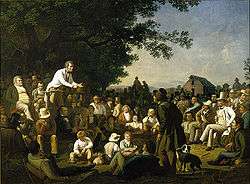Stump speech (politics)

A political stump speech is a standard speech used by a politician running for office. Typically a candidate who schedules many appearances prepares a short standardized stump speech that is repeated verbatim to each audience, before opening to questions.[1]
Origins
The term is derived from the custom in the 19th century in America when political candidates campaigning in rural areas stood on a tree stump to deliver a standard speech.[2] Because the busy pace of campaigning often forces candidates to address people several times per week or even per day, the candidate and his or her staff will usually write a single speech to be delivered at most public appearances.[3]
The beginning of the speech is usually tweaked to include mentions of local elected officials and campaign staff, with local references sometimes peppered throughout, but most of the speech remains identical from day to day. The need for a stump speech stems from a desire to keep candidates focused on their message and to consistently present certain arguments or point out certain aspects of their political platform. Reporters who hear the same speech over and over get bored and have trouble finding material to write about. [4]
U.S. campaigns
In presidential campaigns in the United States, a candidate's speech at his or her party's presidential nominating convention usually forms the basis for the stump speech for the duration of the national campaign.
Stump speeches are not meant to generate news, outside of local media covering a candidate's appearance. National media usually ignore their contents in their daily news coverage. The predictability of stump speeches gives reporters a general indication that the candidate will soon conclude their speech. A famous example of this comes from Governor of New York Nelson Rockefeller, who would constantly use the phrase "the brotherhood of man, under the fatherhood of God" toward the end of his speeches during his multiple bids for the Republican Party presidential nomination. Reporters covering Rockefeller came to abbreviate the expression as BOMFOG.[5]
References
- ↑ Scott L. Althaus, Peter F. Nardulli, and Daron R. Shaw. "Candidate appearances in presidential elections, 1972-2000." Political Communication 19.1 (2002): 49-72.
- ↑ "Stump". Online Etymology Dictionary. Retrieved 2012-11-07.
- ↑ "Stump speech". USLegal.com. Retrieved 2012-11-07.
- ↑ Daniel C. Hallin, "The candidate and the reporter: Whose campaign is it, anyway?." Columbia Journalism Review 29#5 (1991): 43+
- ↑ "Nelson Aldrich Rockefeller, 41st Vice President (1974-1977)". United States Senate. Retrieved 2012-11-07.
External links
An example is provided by the Washington Post on a 2008 presidential candidate Barack Obama speech, complete with time line, segmentation and videos. http://www.washingtonpost.com/wp-dyn/content/graphic/2008/02/26/GR2008022600417.html.